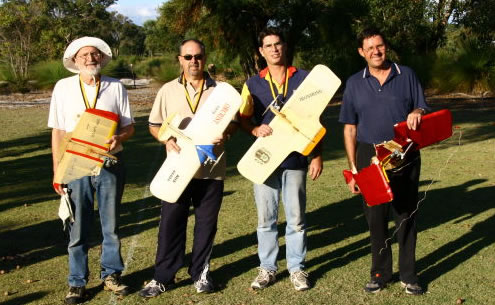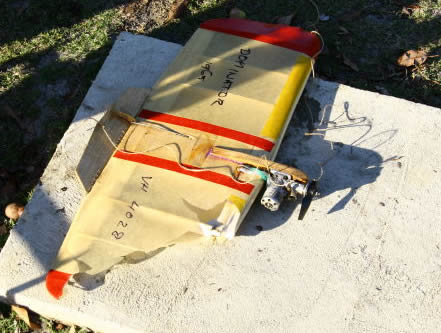| The
rules we use in WA for Vintage Combat permit the use of glow
motors made prior to 1970. The best of these are the Super
Tigre G20/15 and the G15. I have rarely come across a contemporary
diesel motor that can match them, although the G20/15 diesel
of Mark Ellins was a match for my G15 at the first Busselton
Nats. I have also seen Gary Turna’s diesel (type unknown)
come close to matching the G15.

However, in both of these cases I was
using the highly flexible Taipan 7X4 obtained via Kim Parks,
which is somewhat down in performance over the older, rigid
Taipan 7x4. As a genuine Vintage pilot (flying the same G15/Dominator
combo in the 1960’s), my favourite prop was the Tornado
7X4, which could tow the Dominator at 90 MPH on 60’
lines (single strand .012”), which meant the model could
also be used in Open Combat, a quite remarkable circumstance.
At that time, I was using Burford manufactured
pistons diamond lapped by Andy Kerr. These pistons got better
and better with more running, until the point was reached
where the Tornado 7X4 threw blades and the conrods started
to fail. As the replacement Super Tigre conrods were of poor
quality, and my pistons were ruined by the passage of their
disintegrated parts through the motor, I rather lost interest
in continuing with the old FAI combat. I also tried the Kavan
“fibreglass” 7x4, but its blades flew off before
it even got in the air.

As a consequence, my return to Vintage Combat
in the late 1990’s meant I had to find a source, not
only of G15’s, but also of conrods that would not break.
Fortunately a bucketful of cash sufficed to twist Steve Rothwell’s
arm, and he made a bunch of G15 rods to my specifications,
which I now offer for sale at $40 each. These rods have massive
bushed big-ends, similar in size to the later Rossi 15 MkII.
They may give rise to a slightly higher level of motor vibration,
but this is acceptable when one gains such a leap in reliability.
Also the tags on the gudgeon pin retaining circlips should
be cut short, as they fatigue, snap off and wreck both the
piston and head.
Re props, I am not allowed by the rules to
use my own fibreglass props, and I am unaware of a suitable
alternative to the rigid Taipan 7X4 of yesteryear. I cannot
understand why production of this excellent prop was resumed
using the wrong material.
G15’s in various states of repair appear
from time to time on ebay; even new, unrun motors show up,
so they can still be obtained fairly readily. There is a concern
I have with new G15’s. The finish on the piston ex-factory
was rather rough, which, while great for running in, did nothing
for later performance, either in power output or ease of starting.
It was my practise to polish the piston, and then accept an
extended running-in period: the running in was done at 22000
RPM, the G15’s peak power RPM, but with a light load,
such as a 7X4 cut down to 6X4. And of course, I would not
even consider running the motor with the factory conrod: it
is a disaster waiting to happen.
I notice my missive is rather dwelling on the
G15, but my following comments apply to any glow motor used
in Combat, so please persist with my ramblings.
The classic argument against using glow motors,
and in favour of Diesel motors, is the supposed ease of starting
and restarting hot of the latter. I cannot say that my observations
support the former, or, with less rigour, the latter. My G15
starts first flick, on tune and ready to launch. The Diesel’s
seem to need to warm up, and require some fiddling with tune
to get going. That loses bouts.
So how come my G15 starts so easily, while
others flick and flick to no avail?
Here are the secrets.
- The G15 is best run on pressure, which usually
means crankcase pressure. It is very easy to flood the motor
with this set-up, and a flooded G15 will not start, period.
My procedure is designed to stop flooding, and have just
the right amount of fuel in the motor for it to start first
flick. After filling the tank (which needs to be 90cc for
a 4-minute bout), I leave the pressure line disconnected.
Then I flick it over to see if it is flooded, by some misadventure.
If it seems wet, I turn the model so that transfer passage
is on the lower side of the motor, with head pointing down
also. This ensures that excess fuel in the crankcase runs
down the transfer port into the head. This excess is drained
off by raising the head and opening the exhaust port so
that the flood can run out. If this is done correctly, the
motor can be flicked over without locking up due to too
much fuel in the head. By now the plug is probably full
of fuel, so remove it and blow out the excess and check
for a good strong glow. Return the plug, and start the motor
to burn out any remaining fuel and leave the motor dry.
Allow the motor to cool.
- The motor is now dry and cool. With the pressure
line still disconnected, tilt the model so that the head
is upright, and dribble about 8 drops of fuel into the venturi.
Flick the motor over repeatedly, until you feel that the
motor is nice and wet. This foreplay guarantees a quick
start. Close the exhaust port.
- Await the combat Marshal’s order to
start. Tilt the model so that the head is slightly upright,
so that if there is, by some horrible error, too much fuel
in the head, it will run out the exhaust port. Connect the
pressure line and attach the glow leads.
- Give the prop a nice sharp bang backwards
against compression and it will start immediately. Tip the
model so that head is slightly down, to ensure the fuel
pick-up is in the fuel, and if necessary do a last minute
tune. It is best to go off slightly on the rich.
- If the motor does not start right off, immediately
disconnect the pressure line. The motor is either too dry
or too wet. Respond accordingly. With practise, you will
get the starting mixture right and never have this problem.
- If the motor does not have a good piston/cylinder
seal, it will not start when hot, or even warm. The heat
from the sun is enough to stop the motor from starting:
it must be cold. Put a rag over the motor to keep the sun
off, and put a squirt of raw fuel over the cylinder to cool
it further.
- Hot restarts cannot be guaranteed by
any method I know. The best you can do is drench the motor
with fuel to cool it, and ensure the motor has not flooded.
A hot, flooded, G15 will not start.
Well that’s about it. In respect of the
foregoing, I owe a debt of thanks to John Williams, Andy Kerr,
Steve Rothwell, Mark Giggins and Trevor Letchford. If anyone
out there wants to sell G15 bits in good condition, I am interested
(but not in conrods!)
|